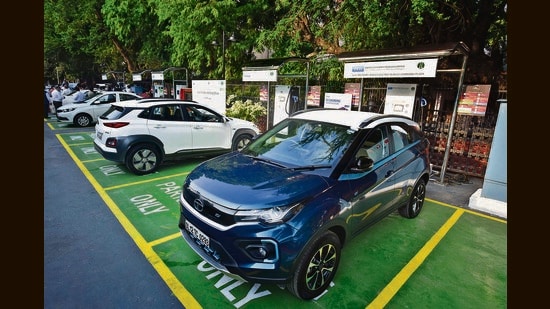Our Terms & Conditions | Our Privacy Policy
Upgrades in store for India’s highways for EV era | Latest News India
Nearly 5,500 km of key national highway stretches connecting Delhi-Mumbai, Delhi-Kolkata, and Kolkata-Kanyakumari, are set to be upgraded into electric or e-highways under the National Highways for Electric Vehicles (NHEV), on a public-private partnership (PPP) model.
The first set of NHEV’s charging stations –– totalling eight with two each in the north, south, east, and west zones –– will be operational by March 2026. (Sanchit Khanna/HT PHOTO)
Abhijeet Sinha, programme director at NHEV, said that while the primary goal is to provide adequate charging infrastructure, the programme will offer auto-triggered roadside assistance for EVs within 30 minutes in case of a breakdown, clean toilets, and other airport-like amenities at intervals of every 50km on these highways.
“The ‘e’ not only means electric but also electronic. With the application and installation of Internet of Things (IoT) devices as part of a large V2X (Vehicle-to-Everything) infrastructure ecosystem, including cameras and sensors, we will be able to improve law enforcement and cater to emergencies better due to the availability of precise data on location, speed, and condition of the vehicle,” said Sinha.
Unlike many developed countries, such as Germany, where overhead catenary wires, as used by electric trains and trams on select lanes of major highways, support charging on the go, NHEV will be operated through charging stations.
These stations will function out of way-side amenities (WSAs) on national highways and private land along the road, spaced 50km apart. Each station will have two roadside assistance vehicles and ambulances dedicated specifically for addressing incidents that occur within a 25km radius. Each NHEV station will have 3200 kWh capacity with 36 chargers, EV service centres, toilets, food court, lounges, ATMs, and other commercial facilities such as salons and warehouses.
“Once these stations start functioning, people will stop going to single charging point stations, as there will be a greater reliability and lesser risk of queuing.”
The first set of stations, totalling eight with two each on the north, south, east, and west zones, will be operational by March 2026. In addition to catering to highway users, Sinha said these stations will also serve as a logistics hub.
“All goods meant to be dropped within a 50-mile radius can be dropped there for last-mile deliveries, and local produce can be sold in these stations. This, in turn, can potentially create many delivery jobs currently limited to big cities,” he added
Initially, these stations will be powered by on-grid power, but soon a mix of off-grid decentralised green power sources, such as solar, hydrogen electrolysers, and wind, will be gradually added in line with India’s 2070 net-zero goal, Sinha said.
For every 10 stations, three will be owned by power and petroleum PSUs, three by power and petroleum private companies, three by private individuals and family offices, while the state government would own one.
Sinha said the ones owned by the state will have a larger area to accommodate a depot of electric buses and trucks. He added that preliminary talks have been held to set up these state government-owned stations/depots in Manesar, Haryana, and Dadri, Uttar Pradesh. Overall, 200 land applications are under review.
The NHEV director noted that this model will not require any government subsidy, with each station being profitable through a mix of revenue streams from the different commercial activities, including those from advertising billboards. “Within 40 months, each station is expected to break even on its initial investment of ₹40-50 crore compared to a 40-year break-even period for government-run chargers,” he said.
Akash Singh, a transportation and infrastructure consultant and partner at global consulting firm Kearney, said that NHEV’s approach is part of a broader national trend of “testing first, scaling later” to de-risk public investment. He said by experimenting with models like battery subscription and vehicle-as-a-service in its trials, NHEV addressed one of the most significant adoption barriers, upfront cost, while creating confidence among inter-city operators.
Adopting EVs is central to achieving India’s commitment to net zero by 2070, with road transport estimated to contribute 12% of all emissions. By 2030, India has set an EV penetration target of 30% in private cars, 70% in commercial vehicles, 40% in buses, and 80% in two-wheelers and three-wheelers. But, EV penetration as of FY 2025 is 7.8%.
HT spoke with some EV users who said that, currently, even for highway travel, there is no range anxiety, but they usually plan well ahead about when and where they will stop for charging.
Vivek Ahuja, an early adopter of EVs in New Delhi, said he has travelled from Delhi to Shimla, Kasauli, Nainital, and Jaipur on his EV without any issue. “On highways, every 50 km, there is availability of fast chargers, and there are multiple popular app-based services which provide reliable options for charging.”
Another EV user, Nishant Jain, echoed the same sentiment, stating range anxiety is a non-issue currently, as each charge gives an approximate range of 400km.
However, as EV adoption increases, public chargers will be needed, particularly for commercial vehicles. Data from the Federation of Automobile Dealers’ Associations (FADA) showed that EV sales registered a 29% jump year-on-year in June.
Currently, there is one charger for every 235 EVs on the road, according to a July report by CareEdge Analytics and Advisory. The report stated that the underdeveloped charging infrastructure has long been a bottleneck for EV adoption in India. In contrast, leading global EV markets, such as China and Europe, maintain a significantly denser network, with one charger for every 7 to 15 EVs, offering greater convenience and reliability to users.
Sinha said NHEV stations will play a key enabling role not only for passenger vehicles but also for heavy-duty vehicles, including trucks, and prevent high queuing.
Images are for reference only.Images and contents gathered automatic from google or 3rd party sources.All rights on the images and contents are with their legal original owners.



Comments are closed.